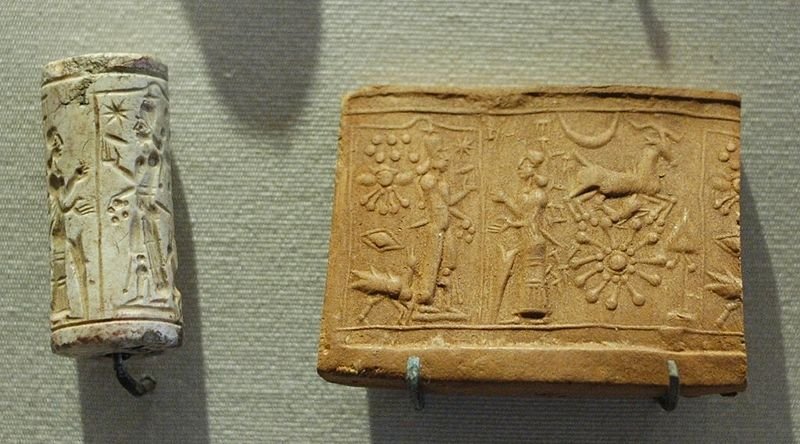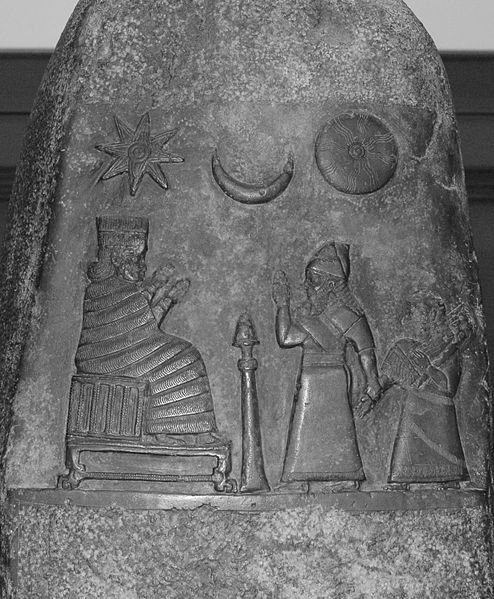Ellen Lloyd – MessageToEagle.com – Shamash was the Sun god in the mythology of the ancient Near East. He was associated with truth, justice, and healing and was one of the most active gods in the pantheons of ancient Sumer, Babylonia, and Assyria. In Sumer, he was worshipped as god Utu.
Shamash was the judge of gods and men
As a powerful solar deity, Shamash, whose consort was the goddess Aya, exercised the power of light over darkness and evil. In this capacity, he became known as the god of justice and equity and was the judge of both gods and men. At night, Shamash became the judge of the underworld.

Shamash was also regarded as a god who released sufferers from the grasp of the demons. The sick appealed to Shamash as the god who can be depended upon to help those who are suffering unjustly. This aspect of Shamash is vividly brought out in hymns addressed to him.
In some cases, Shamash was seen as governing the entire universe and was pictured as a king on his royal throne with his staff and signet ring.

According to legend, the Babylonian king Hammurabi received his code of laws from Shamash.
The Hammurabi codes are some of the earliest and most complete ancient legal codes proclaimed by the Babylonian king Hammurabi, who reigned from 1792 to 1750 BC.
Shamash is depicted as overcoming darkness and death. In the Epic of Gilgamesh, he assisted in the conquest over the monster Humbaba, guardian of the deep forests of Lebanon.
Shamash worship and temples
Shamash was widely worshipped in the ancient near East. The chief centers of his cult were at Larsa, represented by the modern Senkerah in Sumer, and at Sippar, represented by the mounds at Abu Habba in Akkad. Temples dedicated to Shamash were also were erected in all large population centers, including Babylon, Ur, Mari, Nippur, and Nineveh.
In Canaanite tradition, the Sun god was Shemesh, the “torch of the gods,” but was described as female. The worship of Shemesh/Shamash was also practiced among the Israelites, although it was forbidden by the prophets and biblical writers.
Shamash journey through the heavens in his chariot
Shamash, who was the brother of goddess Ishtar is often pictured with a disk that symbolized the Sun. Like the later Apollo, he made his daily journey through the heavens, either on horseback, in a chariot, or on a boat.
Together with Sin and Ishtar, Shamash formed a triad of gods that completed the even older trinity of Anu, Enlil, and Ea, representing the heavens, earth, and water, respectively. The three powers of Sin, Shamash, and Ishtar symbolized three great forces of nature: The sun, the moon, and the morning star (or love and fertility).
Tablet of Shamash
Shamash’s symbol appears on numerous artifacts found in the Near East, including jewelry, cylinder seals, and other objects. One famous example, dating to the 9th century BCE and known simply as the “Tablet of Shamash”, currently housed in the British Museum.
The Tablet of Shamash is a stone tablet recovered from the ancient Babylonian city of Sippar in southern Iraq in 1881. The tablet has serrated edges like a saw, which was the symbol of both Shamash and Saint Simon Zelotes in later tradition. The bas-relief on the top of the obverse shows Shamash, the Sun God, beneath symbols of the Sun, Moon, and Venus. He is depicted in a seated position in a shrine, holding forward a measuring rod and reel of cord. There is another large sun disk in front of him on an altar, suspended from above by two figures.
There is no doubt that Shamash was a very important deity in the Near East.
Written by – Ellen Lloyd – MessageToEagle.com
Copyright © MessageToeagle.com All rights reserved. This material may not be published, broadcast, rewritten or redistributed in whole or part without the express written permission of MessageToeagle.com
Expand for references






